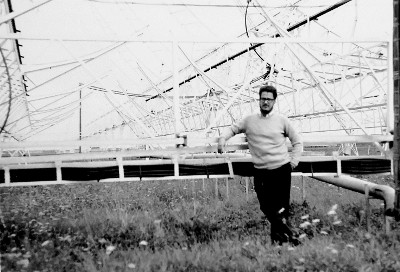 Mario Vigotti (courtesy of family)
Mario Vigotti (courtesy of family)
Mario Vigotti
Contributed by Gavril Grueff
Mario Vigotti died after a long illness in Bologna on 20 January 2021. He was born on 4 August 1943 in Matera (Basilicata). He graduated at the University of Bologna in July 1968 with a thesis on the cosmological implications of the faint radio sources counts, supervisors Prof. Marcello Ceccarelli and Dr. Gavril Grueff.
He started his work in radio astronomy by contributing to the first observations with the Northern Cross Radio Telescope and therefore he is one of the founders of radio astronomical studies in Italy. His activity with the Northern Cross included the first observations of pulsars, a preliminary catalogue of 328 radio sources down to 0.15 Jy in 1968, and later the famous B2 and the B3 catalogues, used to derive the source counts and their implications for models of the Universe.
He led the follow up observations of more than 1000 radio sources at many frequencies, with the VLA and the Effelsberg dish, to carry out statistical studies on structures, spectra, diameters, and investigate the cosmological evolution of the radio sources population. He also made a significant contribution in the optical identifications and redshift measurements of these sources.
He later concentrated on the analysis of radio loud distant quasars, whose redshifts were obtained with big optical telescopes, and that were studied to analyze the density evolution.
He was a very active person in the life of the Istituto di Radioastronomia in Bologna. He had a deep involvement in the technological activity, in particular in software developments and applications. As a member of the Institute Scientific Board, he took part in the decisions about the development of VLBI in Italy and the start of the Sardinia Radio Telescope (SRT) project.
He was very friendly and put many efforts in training young researchers.
He will be remembered for his valuable contributions to the birth of radio astronomy in Italy.
Modified on Sunday, 28-Mar-2021 11:51:35 EDT by Ellen Bouton, Archivist (Questions or feedback)
|
![[IAU logo]](iau_wb_thumb.jpg)
![[URSI logo]](URSI-logo-thumb.jpg)
![[Karl Jansky at his antenna]](jansky_photo_02_thumb.jpg)
![[Reber's Wheaton antenna]](Reber_Telescope_Wheaton_thumb.jpg)
![[Dover Heights]](Dover_Heights_02_thumb.jpg)
![[4C telescope]](GB61-195_4C_telescope_thumb.jpg)
![[Ewen and horn antenna]](ewen_horn1s.jpg)
![[Dwingeloo, 1956]](Dwingeloo-1956-thumb.jpg)
![[Jocelyn Bell Burnell and Cambridge antenna used in pulsar discovery]](burnell2_thumb.jpg)
![[Lovell Telescope at Jodrell Bank]](site_1594_0001-500-334-20180316163019-thumb150.jpg)
![[Wilson, Penzias, and Bell Labs horn antenna]](wilson-penzias-horn_thumb.jpg)
![[6-m Millimeter Radio Telescope in Mitaka, Japan]](6m-thumb.jpg)

